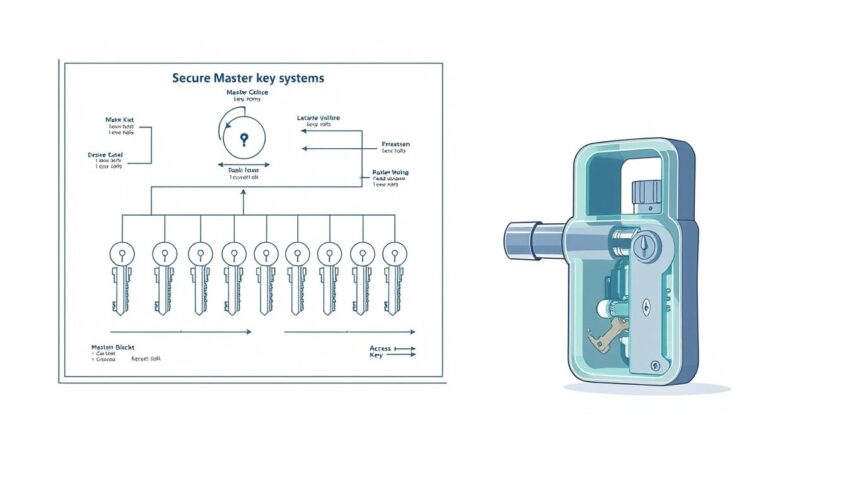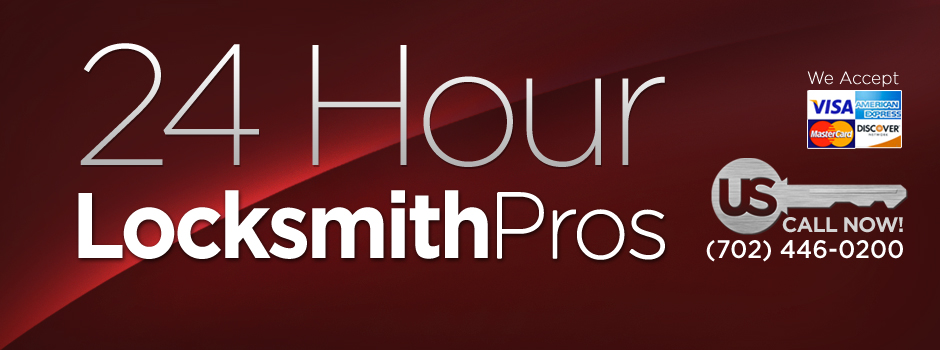Call Now! (702) 659-8090
In today’s world, knowing about master key systems is key for good access control. These systems let you open many locks with just one key. This is super helpful in big places where there are lots of doors.
Master key systems also make it easier to manage keys. They help keep things secure by letting you control who can get where. This guide will cover all you need to know about master key systems. We’ll look at their benefits, how they work, and the best ways to use them for better security and easy access.
Key Takeaways
- Master key systems allow multiple keys to operate the same lock, streamlining access control for businesses.
- They enhance security by minimizing risks associated with theft and crime through role-based access restrictions.
- Using a single key for multiple locks improves efficiency, reducing the bulkiness of large keyrings.
- Delegation of keys is simplified, which facilitates tracking access to specific areas, further improving security.
- New locks must be properly integrated into the master key system to avoid the need for multiple keys.
- Understanding the various levels of keying systems can help you choose the right structure for your needs.
What Are Master Key Systems?
A master key system makes access control easier and safer in many places. It lets one key open many locks, which is great for places with lots of access needs. This system helps manage keys better and keeps things secure.
Diamondback Locksmith
609 N Scottsdale Rd Ste E
Scottsdale, AZ 85257
(480) 360-5371
https://diamondbacklockandkey.com/scottsdale-locksmith-company/
Definition and Overview
A master key system is like a security map for buildings. It lets one key unlock many doors, making it easy for those who should get in. But, it keeps areas that shouldn’t be entered secure. This is why it’s used in places like offices and schools.
How They Work
Each lock in a master key system knows its own set of keys. Master keys can open all doors, while change keys can only open one. This makes a clear order that helps keep things safe. It also lets places control who can go where, making security better.
Types of Master Key Systems
There are different kinds of master key systems, each with its own level of security. Here are a few:
- Standard Systems: These have basic key control with a master key and user keys.
- High-Security Systems: These use special keys and key blanks to stop unauthorized copying, making key control tighter.
- Corporate Systems: These have Grand Master and Great Grand Master keys for managing access in many buildings.
Picking the right system is key to finding the right mix of ease and safety.
| Type of System | Access Levels | Key Control |
|---|---|---|
| Standard | Master, User | Low |
| High-Security | Master, User, Restricted | High |
| Corporate | Great Grand Master, Grand Master, Master | Customized |
Benefits of Using Master Key Systems
Master key systems have many benefits. They are great for homes and businesses. They help manage keys well and save money. Here are the main reasons to use them.
Enhanced Security
Master key systems make places safer. They let owners control who gets in. This cuts down on unwanted visitors.
They also stop people from making copies of keys. This is good for businesses. It makes sure only the right people can get in.
Convenience and Accessibility
Master key systems are easy to use. They let you open many locks with just one key. This is helpful in busy places.
They make work easier for companies. They help staff get where they need to go fast. This is great in emergencies.
Cost-Effectiveness
Master key systems save money. They cut down on costs for making new keys. They also make it easier to get help when needed.
Even if you lose a master key, it’s worth it. They offer a lot of benefits. This makes them a smart choice.
Applications of Master Key Systems
Master key systems are used in many places. They are found in homes, big businesses, and schools. These systems make it easier to get in and keep others out. They help keep things safe and organized.
Residential Use
Homeowners use master key systems for different doors in their homes. It lets family and workers in easily. But, it keeps unwanted people out. This makes homes safer and harder for intruders to get in.
Commercial and Industrial Applications
Big places like offices use master key systems too. Managers can control who goes where. This keeps important areas safe and makes things run smoother.
It also saves money by not needing to replace keys often. This makes businesses more efficient and cost-effective.
Institutional Environments
Schools, hospitals, and government buildings use master key systems too. They make places safer and easier to manage. With these systems, only the right people can get in.
This keeps important areas safe. It also helps in emergencies by letting the right people in quickly.
Components of a Master Key System
Master key systems have key parts that work together. They offer good security and easy access control. Knowing these parts helps organizations set up a strong key system that fits their needs.
Key Types and Variations
There are many types of master keys, like grand master and sub-master keys. Grand master keys open all locks, while sub-master keys open some. This setup helps manage access levels well.
It makes it easier to give access based on roles. Using master key systems can cut the number of keys needed by up to 70%.
Locks and Hardware
Locks in master key systems vary a lot, from simple to electronic ones. Picking the right locks is key to meeting security needs. Electronic locks add security and let you manage access remotely.
Locks that support master keying policies help keep access secure. This makes the whole system stronger against unauthorized entry.
Key Control Procedures
Good key control is the heart of security. It’s important to keep track of who has keys and when. Electronic systems help by storing keys safely and keeping records of who has them.
Reporting lost or stolen keys fast is key to stopping unauthorized access. Access should match daily work needs, not just exceptions. This keeps security tight.
| Component | Description | Benefits |
|---|---|---|
| Key Types | Includes grand master, sub-master, and single master keys for varying access levels. | Reduces the total number of keys and enhances access management. |
| Locks | Variety of locks from traditional to electronic options. | Improves overall security with advanced features. |
| Control Procedures | Involves tracking key distribution and permissions. | Helps in managing unauthorized access effectively. |

Designing an Effective Master Key System
Creating a good master key system needs careful thought. You must look at security needs, make a keying plan, and use strong strategies. This makes access easier and improves key management. It’s key for places with many doors.
Assessing Security Needs
First, check the property’s security needs. Find out what’s vulnerable and what needs protection. Knowing this helps make a system that keeps things safe and lets people in when needed.
Creating the Keying Plan
A good keying plan helps managers know how many keys are needed. It shows which areas can be accessed and who gets which keys. Using software for key management makes tracking easier and keeps things secure.
Implementation Strategies
Good strategies are key for a master key system to work. Training staff on key management is important. Also, the right locks and hardware make the system better. Think about growing your system to avoid costly updates later.
| Level of Access | Description | Example Usage |
|---|---|---|
| Change Key | Access to a specific lock | Individual offices |
| Master Key | Access to multiple locks | Department access |
| Grand Master Key | Access across multiple master key systems | Building-wide access |
| Great Grand Master Key | Access to all locks | Administrator access |
A solid master key system helps manage keys well and boosts security. Using electronic key control makes managing keys easier. It helps protect valuable things and places.
Challenges in Master Key Systems
Master key systems make things easier but also bring big challenges. Users face the hard task of managing security keys well. This is to avoid losing the benefits these systems offer.
Key Duplication Risks
Key duplication without permission is a big problem. It can lead to serious security issues. To fix this, companies need to control key duplication tightly. They must have a good plan for managing security keys to stop unauthorized access.
Maintenance and Management Issues
Keeping a master key system running is hard work. Keeping track of keys and checking them often is key. This work can be too much for some teams, showing the need for experts in security key management.
Security Vulnerabilities
There are also big security risks. If the main key gets lost or stolen, the whole system is at risk. To stay safe, it’s important to check and update keyless entry systems often. This keeps everyone’s access secure.

Best Practices for Master Key Systems
Using the best practices for master key systems makes security better and work smoother. Companies need to check things often, train people, and update their key systems. This keeps security high and makes access easy.
Regular Audits and Inspections
Checking keys and access points often is key to keeping systems safe. Finding and fixing problems early makes security stronger. A case study with Anderson Lock showed how important this is. They worked with 20 schools in a Chicago suburb, handling thousands of keys and locks.
Training and Education
Training helps employees understand the master key system’s value. They learn how to handle keys and locks. This makes everyone more responsible and helps them use security measures well.
Updating Keying Systems
Keeping key systems up-to-date is essential for security. Companies should track key details and use cloud-based tracking. This makes managing keys easier and more secure.
| Best Practice | Description | Benefits |
|---|---|---|
| Regular Audits | Conduct audits of all keys and access points. | Identifies discrepancies, enhances security. |
| Training | Provide training on key and lock management procedures. | Promotes employee accountability, knowledge retention. |
| Updating Systems | Review and update keying systems based on new security needs. | Ensures current information and responsiveness to changes. |
Conclusion: Mastering Your Key Control
Master key systems are key to better access management. They make security and convenience easier for businesses. By sorting keys by access level, companies can cut down on lost or copied keys.
These systems are also cost-effective. They save money by not needing many locks or extra security gadgets. This makes managing keys simpler and boosts work efficiency.
Choosing the right master key system is important. Businesses need to think about their access needs, budget, and any weak spots. Working with experts like Diamondback Locksmith is a good idea. They make sure the system fits your business needs.
Also, making sure the system meets local rules is key. This way, emergency responders can get in fast, keeping everyone safe.
Using new tech like key management software and wireless locks can make master key systems better. Keeping up with the latest in the field helps manage these systems well now and in the future.



